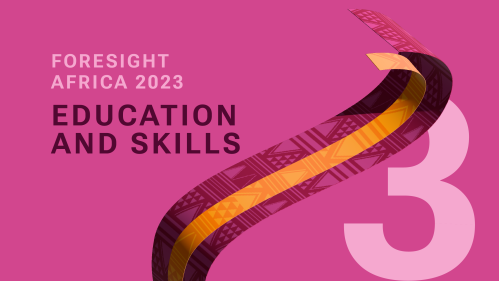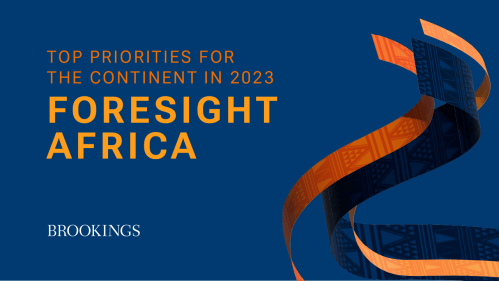Below is a viewpoint from the Foresight Africa 2023 report, which explores top priorities for the region in the coming year. Read the full chapter on education and skills.
 “It is within the possibility of science and technology to make even the Sahara bloom into a vast field with verdant vegetation for agricultural and industrial developments.”
“It is within the possibility of science and technology to make even the Sahara bloom into a vast field with verdant vegetation for agricultural and industrial developments.”
Former President of Ghana Kwame Nkrumah’s statement above on the promise of science and technology is as pertinent today as it was in 1963. It is indeed breakthroughs in science and technology, driven by a workforce skilled in science, technology, engineering, and mathematics (STEM), that will enable Africa to overcome crippling development challenges including climate change, food insecurity, inequality, and poverty. And the one-fifth of the global population under the age of 25 who currently reside in sub-Saharan Africa will need STEM skills to drive economic transformation and competitiveness.
STEM education inculcates problem-solving, critical-thinking, communications, collaboration, and digital skills. Young people need these skills to build the resilience to navigate an uncertain future where technological advances will fundamentally alter industries and eliminate about one-half of the jobs today.
The STEM education landscape in Africa is characterized by risk and opportunity. While effectiveness is hampered by resource and capacity constraints, opportunity lies in centers of excellence and promising pathways of policy and practice.
The Science, Technology, and Innovation Strategy for Africa (STISA) provides the regional STEM policy framework. Centres of excellence such as the Centre for Mathematics, Science and Technology Education in Africa (CEMASTEA), provide implementation support to countries. And with varying degrees of success, at least 10 countries, are implementing a competency-based curriculum (CBC) which emphasizes inquiry-based learning, STEM, and Technical and Vocational Education and Training (TVET). For example, coding and computer programming is part of the CBC digital learning program in Kenya.
You cannot code without basic numeracy, neither can you innovate if you lack the basic skills to acquire and apply knowledge.
Low education quality is however a binding constraint. And yet, even before the COVID-19 pandemic exacerbated the situation, more than 50 percent of children in basic education in sub-Saharan Africa were unable to read and understand a simple age-appropriate story.
A critical first step towards improving STEM education, therefore, is to get the basics right. We can achieve vast improvements in strengthening foundational skills by integrating into teaching and learning: new and exciting knowledge on the science of learning, and recent evidence from neuroscience on how the human mind works.
There are also huge benefits to achieving universal basic skills. It would raise future world GDP by $700 trillion over the remainder of the century which would be transformative for low-income countries.
Recent studies (ADEA and ACET 2022), indicate that the two greatest constraints to STEM education are inadequate facilities and sub-optimal teacher classroom practices. Schools can provide minimum STEM and other facilities if countries allocate at least 20 percent of their budget to education.
In the countries surveyed, STEM and computer labs exist but less than half of them are functional, while a lack of facilities inhibits practical training. Second, the STEM gender gap widens progressively through school in part because of under representation of female STEM teachers. In Ghana, only 5 percent of STEM teachers in the upper grades are female. Less than 25 percent of students pursue STEM-related career fields in higher education in sub-Saharan Africa as a result of a compounding of these issues reduces.
Closing the gender gap in STEM education is a “best buy.” Women are key to addressing the existential challenges that face the continent. They account for 60 percent of the farmers in Africa and are the primary providers of water and firewood. With strong STEM skills, women could be at the vanguard of environmental sustainability and adoption of agricultural technology. A quantum leap in child survival, national health, and education attainment could be achieved if women as the gatekeepers to child health and family welfare obtain at least 12 years of science-driven basic education.
Successful interventions include targeted scholarships, mentorship using role models, and early exposure to STEM based career opportunities. Moreover, through digital technology, students in resource constrained environments can tap into expert STEM training. Rwanda’s One-Laptop-Per-Child (OLPC) flagship program, Kenya’s digital learning program, the university of Colorado science simulation program, PhET, and massive open online courses (MOOCs) such as EdX, have demonstrated the leapfrogging potential of digital learning.
But we can go even further to nurture and build upon these green shoots that are sprouting on the continent by:
- Creating an interactive classroom-industry interface. Kenya has over 1,000 start-ups that could provide such an interface to give students relevant work exposure, sharpen their focus, and raise their ambition in STEM.
- Nurturing and rewarding excellence in STEM. Africa is brimming with creative, home grown innovations. Norah Magero’s Vaccibox, a small, mobile, solar-powered fridge that safely stores and transports medicines, for use in remote clinics and Charlot Magayi’s Mukuru Clean Stoves, which uses processed biomass to create 90 percent less pollution than an open fire, demonstrate the huge reservoir of talent in the continent. These two women innovators from Kenya have recently won international awards. Competitions such as the Young Scientists Kenya (YSK), which aim to catalyze and spotlight the quality of STEM, have proved useful in tapping into the innovative energy of secondary school students.
- And finally, we need to strengthen the training of STEM trainers. We can do so by providing targeted financing incentives to higher education institutions that offer STEM programs. Furthermore, we need to reinvigorate and protect specialization of universities, such as the Technical University of Kenya or Jomo Kenyatta University of Technology and Agriculture, that were originally designed as centers of excellence in STEM.





Commentary
STEM education in Africa: Risk and opportunity
February 10, 2023